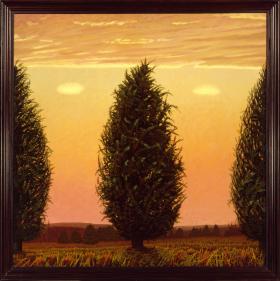- Students view various works of art from the Museum that are examples of the transformations (PowerPoint). For each work of art, teacher asks the following:
- What do you see?
- What does this work of art make you wonder?
Teacher then asks students if the work of art contains an example of slide, flip, or turn, as directed in the PowerPoint presentation. After the presentation, the teacher reviews the elements of art and principles of design and asks the following:
- How have the artists applied the principles of design in these works of art?
- Why might the artists have created works of art that feature symmetry?
- What might the artists need to know about math to create these works of art?
- How might you use the principles of design in creating your own work of art that features slide, flip, or turn?
- Students are given a description of the project and examples (PowerPoint).
- Students find the center of their graph paper and create a coordinate plane.
- Students draw a diagonal line through quadrants to form an X.
- Students plan then construct their design in one half of one quadrant then transform the design to the other half.
- Students replicate the design to the other quadrants.
- Students color the design using symmetrical color scheme.
- Students record the original coordinates of at least five shapes, describe the transformation, and then record the new coordinates of the figures.
- Students complete a self-assessment of their work using a rubric.
- Teacher assesses the work using a rubric.
- Student handout will be used to assess students’ ability to describe the effect of dilations, translations, rotations, and reflections on two-dimensional figures using coordinates.
- Rubric will be used to assess student planning and creation of a work of art that demonstrates understanding of transformation and congruence.
- Student self-assessment will be used to assess students’ ability to critique art based on persobe used to assess student planning and creation of a work of art that demonstrates understanding of transformation and congruence.
coordinate plane
ordered pair
x-coordinate
y-coordinate
quadrant
symmetry
transformation
translation (slide)
rotation (turn)
reflection (flip)
- Slides of works of art
- Power Point
- Graph paper
- Pencils
- Rulers
- Crayons or colored pencils
- Notebook paper
- Rubric
Throughout much of the twentieth century, American art was dominated by the city. Landscape painting, which earlier had held a central place in American art, became little more than a sideline pursuit. In the final decades of the century, however, landscape painting enjoyed a dramatic revival, prompted partly by deepening awareness of the environmental crisis. John Beerman's paintings are poetic meditations on the enduring power of nature. Three Trees, Two Clouds was inspired by the country around Haw River in Alamance County, North Carolina. But the artist has done more than factually record. He conjures a surrealistic, dreamlike vision in which twin spectral clouds hover improbably between the trees. Earth and sky are thus united by uncanny symmetry.
Devorah Sperber incorporates everyday materials—thousands of spools of thread, pipe cleaners, colored tacks—to reinvent famous works of art. She is interested in exploring the reproduction of images in the digital era, the links between art and technology, and visual perception—how the eye and brain make sense of the visual world. She starts by scanning a reproduction of a painting to create a color-charted map, which she remakes in three dimensions using small objects to mimic the pixels of digital images. In the process she greatly enlarges the original image and turns it upside down. Viewing the work through the acrylic sphere provided by the artist mimics peripheral vision, turning the image right side up and shrinking it to a recognizable size. Sperber explains that in addition to experimenting with perception, she is equally determined “to provide visual experiences that are compelling enough to stand on their own without any explanation.”
It is a measure of Rodin's genius that he could take a motif as mundane as two hands and create such an evocative sculpture. It brings to mind the vault of a Gothic cathedral -- hence the title. The fingers lightly touch, as if in prayer. Given the intimacy of this gesture, it comes as a surprise when we notice Rodin has used two identical right hands, "forever caught," as one critic wrote, "in marveling reciprocal self-contemplation."


